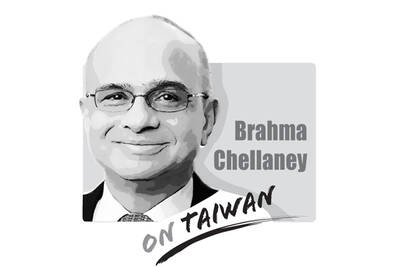In addition to theoretical reasoning, looking back at the following three major events of the 1990s will help us to maintain a realistic perspective when we think over the controversy surrounding a proposed plebiscite and referendum law in a rational manner.
DPP Legislator Trong Chai (蔡同榮) and pro-independence groups led a major march on Sept. 8, 1991, calling for Taiwan's entry into the UN as an independent country. The number of people who participated in the march rivaled that of another protest, on April 17 of the same year, against constitutional amendments introduced by the KMT.
It was a time when the DPP and pro-independence groups had a close relationship. In the summer of 1991, the two held meetings with each other on the creation of a new Constitution. They also called for the demand for a referendum to be incorporated into the DPP party charter.
A public demonstration in 1998 appealed for a plebiscite. Because the general atmosphere at that time did not allow for a detailed investigation of lawmaking problems, the DPP and like-minded groups believed that the end result would be realization of the people's right to self-determination.
Next, when the KMT and DPP worked together in 1997 to amend the Constitution, they reached agreement at a senior level that the people should be legally entitled to exercise a right to call for a plebiscite on national affairs. This idea was written into both parties' individual draft proposals for constitutional amendments.
Although the New Party offered a different version, they basically agreed with the KMT and DPP that the people may exercise the right of referendum. They also froze a clause in Article 27 of the constitution that the National Assembly has the right of initiative and referendum.
In addition, the DPP version of the proposal added that the president may demand a referendum for any national policy of great concern, including the proposed constitutional amendments.
But the focus that year was on freezing the provincial government and the abolition of the Legislative Yuan's power of veto over the president's choice of premier. The proposals concerning the referendum were therefore stillborn.
Third, in the spring of 1999 there was a hunger strike in front of the Legislative Yuan to advocate a referendum law. Many legislators and leading social activists participated. The then KMT legislator Eugene Jao (
Although the proposal stated that referendums would mostly be used to solve sovereignty issues and might "touch off confrontations," it added that they might also "change the present condition of separation."
The proposal was pretty comprehensive, with various clauses related to procedures, results, litigation and penalties. The only items not included were clauses on budget, land taxes, wages and personnel matters.
If the Constitution is the foundation for the operations of a multi-party system in contemporary Taiwan, the pan-blue and pan-green camps have a common responsibility to implement those articles of the constitution that stipulate that "the people shall have the right of election, recall, initiative and referendum," and that "the exercise of the rights of initiative and referendum shall be prescribed by law."
The people should take action against those political figures who flagrantly violate these constitutional articles and usurp the people's rights.
Chen Yi-shen is an associate research fellow at the Academia Sinica's Institute of Modern History and vice chairman of the Northern Taiwan Society.
Translated by Grace Shaw

As strategic tensions escalate across the vast Indo-Pacific region, Taiwan has emerged as more than a potential flashpoint. It is the fulcrum upon which the credibility of the evolving American-led strategy of integrated deterrence now rests. How the US and regional powers like Japan respond to Taiwan’s defense, and how credible the deterrent against Chinese aggression proves to be, will profoundly shape the Indo-Pacific security architecture for years to come. A successful defense of Taiwan through strengthened deterrence in the Indo-Pacific would enhance the credibility of the US-led alliance system and underpin America’s global preeminence, while a failure of integrated deterrence would
The Executive Yuan recently revised a page of its Web site on ethnic groups in Taiwan, replacing the term “Han” (漢族) with “the rest of the population.” The page, which was updated on March 24, describes the composition of Taiwan’s registered households as indigenous (2.5 percent), foreign origin (1.2 percent) and the rest of the population (96.2 percent). The change was picked up by a social media user and amplified by local media, sparking heated discussion over the weekend. The pan-blue and pro-China camp called it a politically motivated desinicization attempt to obscure the Han Chinese ethnicity of most Taiwanese.
On Wednesday last week, the Rossiyskaya Gazeta published an article by Chinese President Xi Jinping (習近平) asserting the People’s Republic of China’s (PRC) territorial claim over Taiwan effective 1945, predicated upon instruments such as the 1943 Cairo Declaration and the 1945 Potsdam Proclamation. The article further contended that this de jure and de facto status was subsequently reaffirmed by UN General Assembly Resolution 2758 of 1971. The Ministry of Foreign Affairs promptly issued a statement categorically repudiating these assertions. In addition to the reasons put forward by the ministry, I believe that China’s assertions are open to questions in international
The Legislative Yuan passed an amendment on Friday last week to add four national holidays and make Workers’ Day a national holiday for all sectors — a move referred to as “four plus one.” The Chinese Nationalist Party (KMT) and the Taiwan People’s Party (TPP), who used their combined legislative majority to push the bill through its third reading, claim the holidays were chosen based on their inherent significance and social relevance. However, in passing the amendment, they have stuck to the traditional mindset of taking a holiday just for the sake of it, failing to make good use of